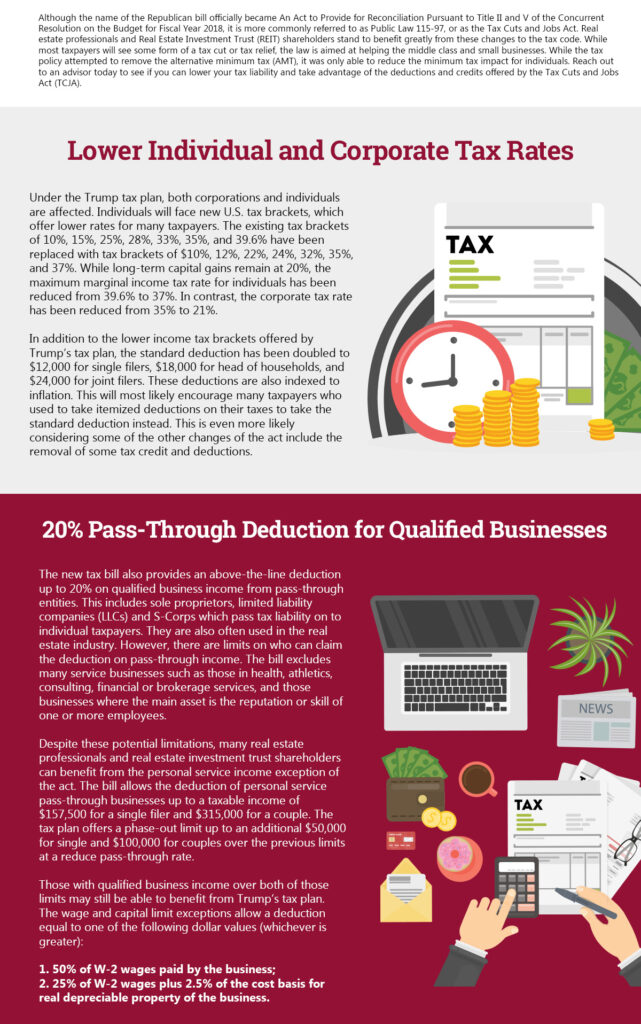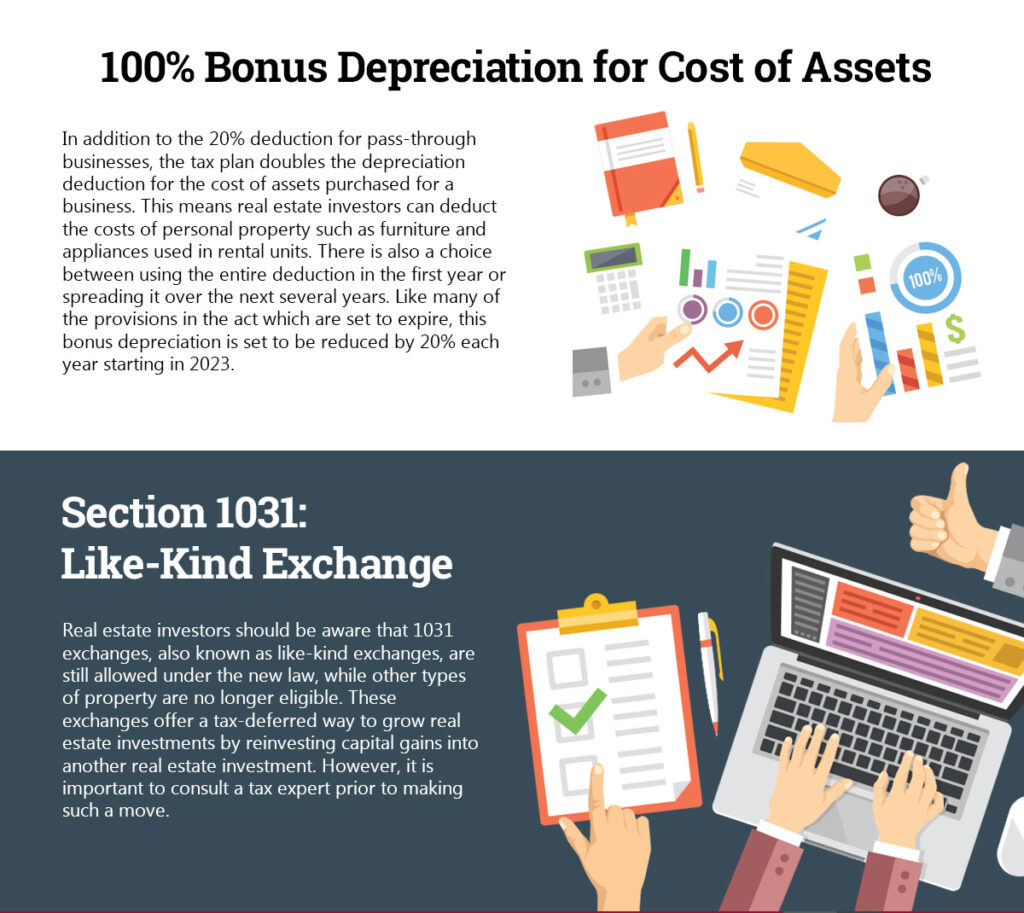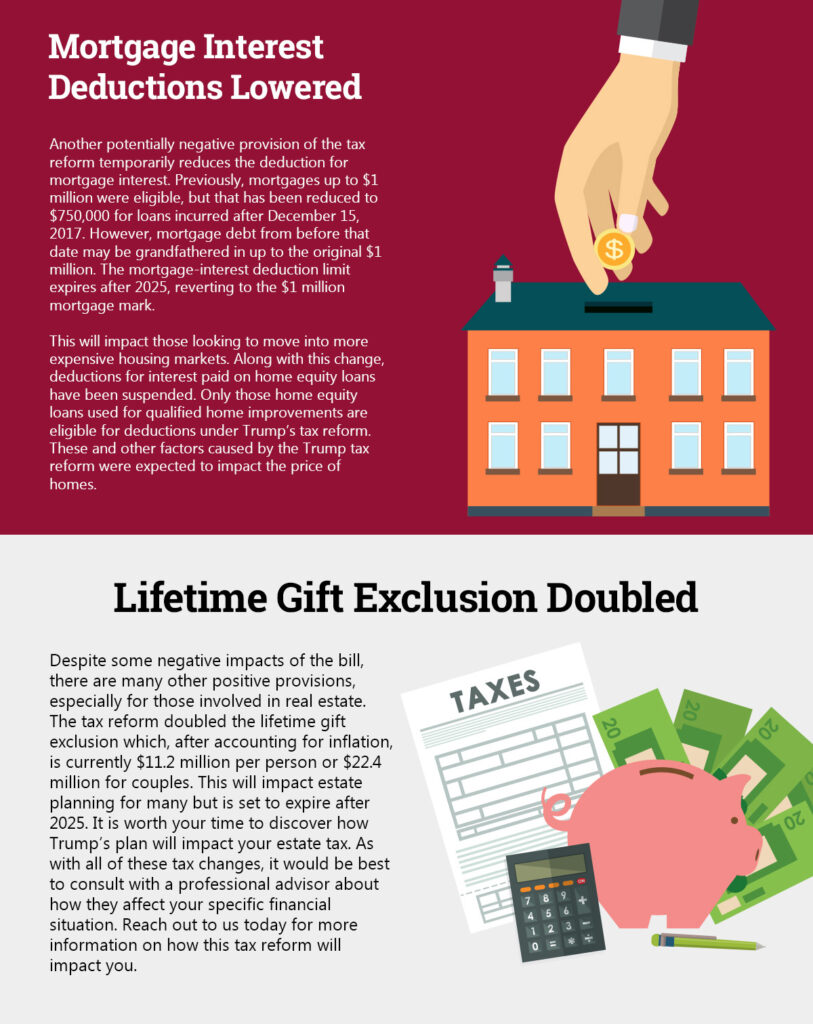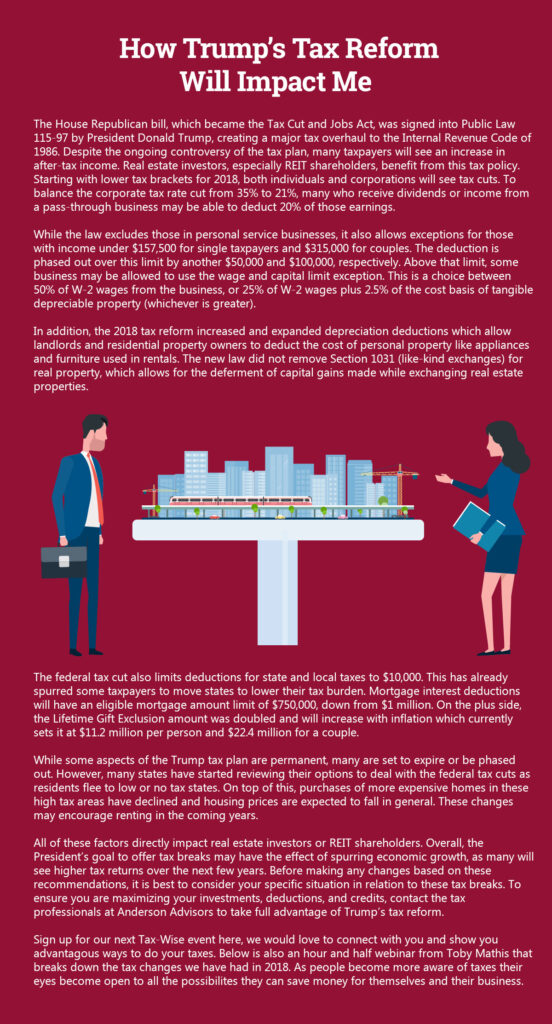Updated October 12, 2021
On December 22, 2017, Donald Trump signed into law what has become known as the Tax Cuts and Jobs Act or Public Law 115-97. This act amends the Internal Revenue Code of 1986 in many ways, and for the most part greatly benefits corporations and individual taxpayers, especially those in real estate. Below are eight facts that real estate investors need to know about the tax changes.
8 Things Investors Need to Know About the Trump Tax Reform
- Lower Individual and Corporate Tax Rates
- 20% Pass-Through Deduction for Qualified Businesses
- 100% Bonus Depreciation for Cost of Assets
- Section 1031: Like-Kind Exchange
- State and Local Tax Deductions Capped at $10,000
- Mortgage Interest Deductions Lowered
- Lifetime Gift Exclusion Doubled
- Impact on Real Estate Professionals and Investors

Although the name of the Republican bill officially became An Act to Provide for Reconciliation Pursuant to Title II and V of the Concurrent Resolution on the Budget for Fiscal Year 2018, it is more commonly referred to as Public Law 115-97, or as the Tax Cuts and Jobs Act. Real estate professionals and Real Estate Investment Trust (REIT) shareholders stand to benefit greatly from these changes to the tax code. While most taxpayers will see some form of a tax cut or tax relief, the law is aimed at helping the middle class and small businesses. While the tax policy attempted to remove the alternative minimum tax (AMT), it was only able to reduce the minimum tax impact for individuals. Reach out to an advisor today to see if you can lower your tax liability and take advantage of the deductions and credits offered by the Tax Cuts and Jobs Act (TCJA).
Free Strategy Session with an Anderson Advisor
Receive a detailed risk assessment to assist in lowering problem areas that could wipe out all of your assets with one wrong move. Speak with an Anderson Professional Advisor to get your FREE Strategy Session. Limited-Time offer: FREE (a $750 value.)
Lower Individual and Corporate Tax Rates
Under the Trump tax plan, both corporations and individuals are affected. Individuals will face new U.S. tax brackets, which offer lower rates for many taxpayers. The existing tax brackets of 10%, 15%, 25%, 28%, 33%, 35%, and 39.6% have been replaced with tax brackets of $10%, 12%, 22%, 24%, 32%, 35%, and 37%. While long-term capital gains remain at 20%, the maximum marginal income tax rate for individuals has been reduced from 39.6% to 37%. In contrast, the corporate tax rate has been reduced from 35% to 21%.
In addition to the lower income tax brackets offered by Trump’s tax plan, the standard deduction has been doubled to $12,000 for single filers, $18,000 for head of households, and $24,000 for joint filers. These deductions are also indexed to inflation. This will most likely encourage many taxpayers who used to take itemized deductions on their taxes to take the standard deduction instead. This is even more likely considering some of the other changes of the act include the removal of some tax credit and deductions.
20% Pass-Through Deduction for Qualified Businesses
The new tax bill also provides an above-the-line deduction up to 20% on qualified business income from pass-through entities. This includes sole proprietors, limited liability companies (LLCs) and S-Corps which pass tax liability on to individual taxpayers. They are also often used in the real estate industry. However, there are limits on who can claim the deduction on pass-through income. The bill excludes many service businesses such as those in health, athletics, consulting, financial or brokerage services, and those businesses where the main asset is the reputation or skill of one or more employees.

Despite these potential limitations, many real estate professionals and real estate investment trust shareholders can benefit from the personal service income exception of the act. The bill allows the deduction of personal service pass-through businesses up to a taxable income of $157,500 for a single filer and $315,000 for a couple. The tax plan offers a phase-out limit up to an additional $50,000 for single and $100,000 for couples over the previous limits at a reduce pass-through rate.
Those with qualified business income over both of those limits may still be able to benefit from Trump’s tax plan. The wage and capital limit exceptions allow a deduction equal to one of the following dollar values (whichever is greater):
1. 50% of W-2 wages paid by the business;
2. 25% of W-2 wages plus 2.5% of the cost basis for real depreciable property of the business.
100% Bonus Depreciation for Cost of Assets
In addition to the 20% deduction for pass-through businesses, the tax plan doubles the depreciation deduction for the cost of assets purchased for a business. This means real estate investors can deduct the costs of personal property such as furniture and appliances used in rental units. There is also a choice between using the entire deduction in the first year or spreading it over the next several years. Like many of the provisions in the act which are set to expire, this bonus depreciation is set to be reduced by 20% each year starting in 2023.
Section 1031: Like-Kind Exchange
Real estate investors should be aware that 1031 exchanges, also known as like-kind exchanges, are still allowed under the new law, while other types of property are no longer eligible. These exchanges offer a tax-deferred way to grow real estate investments by reinvesting capital gains into another real estate investment. However, it is important to consult a tax expert prior to making such a move.
State and Local Tax Deductions Capped at $10,000
One possible negative aspect of the new tax plan is that deductions for state and local taxes (SALT) have been capped at $10,000. This greatly impacts those with higher incomes living in high-income tax states. Many states are exploring responses to the new tax law that may retain some of the repealed tax benefits for their residents. However, some residents have already started moving to lower or no-income tax states because of these changes.
Mortgage Interest Deductions Lowered
Another potentially negative provision of the tax reform temporarily reduces the deduction for mortgage interest. Previously, mortgages up to $1 million were eligible, but that has been reduced to $750,000 for loans incurred after December 15, 2017. However, mortgage debt from before that date may be grandfathered in up to the original $1 million. The mortgage-interest deduction limit expires after 2025, reverting to the $1 million mortgage mark.

This will impact those looking to move into more expensive housing markets. Along with this change, deductions for interest paid on home equity loans have been suspended. Only those home equity loans used for qualified home improvements are eligible for deductions under Trump’s tax reform. These and other factors caused by the Trump tax reform were expected to impact the price of homes.
Lifetime Gift Exclusion Doubled
Despite some negative impacts of the bill, there are many other positive provisions, especially for those involved in real estate. The tax reform doubled the lifetime gift exclusion which, after accounting for inflation, is currently $11.2 million per person or $22.4 million for couples. This will impact estate planning for many but is set to expire after 2025. It is worth your time to discover how Trump’s plan will impact your estate tax. As with all of these tax changes, it would be best to consult with a professional advisor about how they affect your specific financial situation. Reach out to us today for more information on how this tax reform will impact you.
Impact on Real Estate Professionals and Investors
The Tax Cuts and Jobs Act introduced many benefits for those involved in real estate investing. However, not everyone will benefit from all of these changes. The National Association of Realtors has already noted a slower growth in home prices of 1-3% for 2018. Incentives for home buying have decreased under the tax reform and may not be enticing enough to encourage buying over renting. This could potentially lead to a surge in the rental market over the next few years, and as such, a decrease in rental vacancies.

Rubbing SALT into the wound, those living in high-income tax areas are hit hardest by the tax changes. With the cap on state and local tax deductions, many are moving from those areas to tax-friendly areas such as Florida. Recent estimates show that Florida’s housing market for Naples has seen a 25% increase in purchases of homes over $2 million. In contrast, New York has seen a decline of 16.6% in Manhattan over the same period. Be aware that moving expense deductions have also been removed in Trump’s tax plan, except for armed forces personnel moving under orders.
How Trump’s Tax Reform Will Impact Me
The House Republican bill, which became the Tax Cut and Jobs Act, was signed into Public Law 115-97 by President Donald Trump, creating a major tax overhaul to the Internal Revenue Code of 1986. Despite the ongoing controversy of the tax plan, many taxpayers will see an increase in after-tax income. Real estate investors, especially REIT shareholders, benefit from this tax policy. Starting with lower tax brackets for 2018, both individuals and corporations will see tax cuts. To balance the corporate tax rate cut from 35% to 21%, many who receive dividends or income from a pass-through business may be able to deduct 20% of those earnings.
While the law excludes those in personal service businesses, it also allows exceptions for those with income under $157,500 for single taxpayers and $315,000 for couples. The deduction is phased out over this limit by another $50,000 and $100,000, respectively. Above that limit, some business may be allowed to use the wage and capital limit exception. This is a choice between 50% of W-2 wages from the business, or 25% of W-2 wages plus 2.5% of the cost basis of tangible depreciable property (whichever is greater).
In addition, the 2018 tax reform increased and expanded depreciation deductions which allow landlords and residential property owners to deduct the cost of personal property like appliances and furniture used in rentals. The new law did not remove Section 1031 (like-kind exchanges) for real property, which allows for the deferment of capital gains made while exchanging real estate properties.
The federal tax cut also limits deductions for state and local taxes to $10,000. This has already spurred some taxpayers to move states to lower their tax burden. Mortgage interest deductions will have an eligible mortgage amount limit of $750,000, down from $1 million. On the plus side, the Lifetime Gift Exclusion amount was doubled and will increase with inflation which currently sets it at $11.2 million per person and $22.4 million for a couple.
While some aspects of the Trump tax plan are permanent, many are set to expire or be phased out. However, many states have started reviewing their options to deal with the federal tax cuts as residents flee to low or no tax states. On top of this, purchases of more expensive homes in these high tax areas have declined and housing prices are expected to fall in general. These changes may encourage renting in the coming years.
All of these factors directly impact real estate investors or REIT shareholders. Overall, the President’s goal to offer tax breaks may have the effect of spurring economic growth, as many will see higher tax returns over the next few years. Before making any changes based on these recommendations, it is best to consider your specific situation in relation to these tax breaks. To ensure you are maximizing your investments, deductions, and credits, contact the tax professionals at Anderson Advisors to take full advantage of Trump’s tax reform.
Sign up for our next Tax-Wise event here, we would love to connect with you and show you advantagous ways to do your taxes. Below is also an hour and half webinar from Toby Mathis that breaks down the tax changes we have had in 2018. As people become more aware of taxes their eyes become open to all the possibilites they can save money for themselves and their business.







3 Steps to Create an Invisible Investor Strategy

















